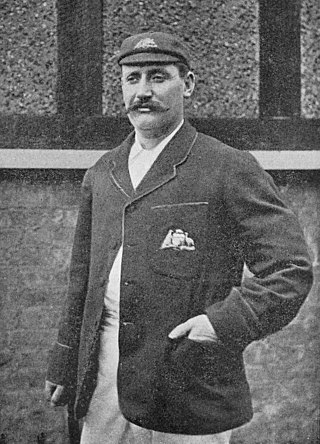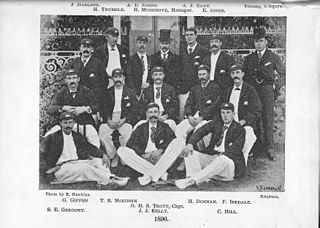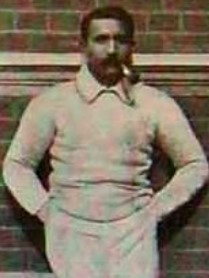The following is an overview of the events of 1897 in film, including a list of films released and notable births.

Colonel Shri Sir Ranjitsinhji Vibhaji II, Jam Sahib of Nawanagar,, often known as Ranji or K. S. [Kumar Sri] Ranjitsinhji, was an Indian cricketer who became ruler of the Indian princely state of Nawanagar from 1907 to 1933. The main part of his cricket career was from 1893 to 1904 when, as one of the greatest batsmen of his time, he played for Cambridge University, Sussex, London County and, in 15 Test matches, for England.

Archibald Campbell MacLaren was an English cricketer who captained the England cricket team at various times between 1898 and 1909. A right-handed batsman, he played 35 Test matches for England, as captain in 22 of those games, and led the team to defeat in four Ashes series against Australia. An amateur, MacLaren played first-class cricket for Lancashire, captaining that county for most of his career. As a batsman, MacLaren was one of the leading cricketers of his time and had a reputation as a fast-scoring stylist. In 1895, he scored 424 runs in an innings against Somerset which was the highest individual score in first-class cricket until 1923 and remained a record in English cricket until 1994. Opinions were divided over his captaincy. He was a deep thinker on the game and critics believed him to be tactically advanced, but his pessimism, clashes with the selectors and inability to get the best out of his players led most commentators to rate him a poor leader.

George Henry Stevens Trott was an Australian cricketer who played 24 Test matches as an all-rounder between 1888 and 1898. Although Trott was a versatile batsman, spin bowler and outstanding fielder, "it is as a captain that he is best remembered, an understanding judge of human nature". After a period of some instability and ill discipline in Australian cricket, he was the first in a succession of assertive Australian captains that included Joe Darling, Monty Noble and Clem Hill, who restored the prestige of the Test team. Respected by teammates and opponents alike for his cricketing judgement, Trott was quick to pick up a weakness in opponents. A right-handed batsman, he was known for his sound defence and vigorous hitting. His slow leg-spin bowling was often able to deceive batsmen through subtle variations of pace and flight, but allowed opposition batsmen to score quickly.

Kumar Shri Duleepsinhji was a cricketer who played for England. Playing in the era before the Indian cricket team, he is considered one of India's first great batsmen, alongside his uncle Ranjitsinhji, who also represented England. Born in present-day Gujarat, he was educated at the Rajkumar College, Rajkot, before moving to England as a boy, where he attended Cheltenham College, and Cambridge University. The Duleep Trophy, long one of the premier competitions in Indian first class cricket, is named after him.

Cricket nets are used by batters and bowlers to practice their cricketing techniques. They consist of a cricket pitch enclosed by netting on either side, behind, and optionally above. The bowling end is left open.
1896 was the seventh season of County Championship cricket in England. Yorkshire won the championship title having lost only losing three of their 26 matches, setting a points percentage record with 68.42. Yorkshire's team did not possess the greatest performers statistically, such as Sussex with Ranjitsinhji, or Gloucestershire with W. G. Grace, but a well-rounded squad with four bowlers taking more than 70 wickets in the Championship and five batsmen scoring over 1000 runs gave them the title. Playing against Warwickshire at Edgbaston in May, Yorkshire scored 887 in their first innings, which is still the highest total in the history of the County Championship.

Lionel Charles Hamilton Palairet was an English amateur cricketer who played for Somerset and Oxford University. A graceful right-handed batsman, he was selected to play Test cricket for England twice in 1902. Contemporaries judged Palairet to have one of the most attractive batting styles of the period. His obituary in The Times described him as "the most beautiful batsman of all time". An unwillingness to tour during the English winter limited Palairet's Test appearances; contemporaries believed he deserved more Test caps.

Nawanagar was an Indian princely state in the historical Halar region, located on the southern shores of the Gulf of Kutch. It was ruled by the Jadeja Rajput dynasty and became the part of newly formed India. Its capital city was Nawanagar city, now known as Jamnagar. It had an area of 3,791 square miles (9,820 km2) and a population estimated at 336,779 in 1901. Its rulers, who use the title of "Jam Saheb" are of the same clan as the Rao of Kutch. They were entitled to a 13-gun salute. The state flag was a rectangular red flag with a white elephant, near and facing the hoist. During the British, the state was part of the Kathiawar Agency, within the Gujarat Division of Bombay Presidency.
1871 was the 85th season of cricket in England since the foundation of Marylebone Cricket Club (MCC). Derbyshire County Cricket Club became a first-class club and the last matches were played by Cambridgeshire, who in the days of Bob Carpenter, the first Tom Hayward and George Tarrant had been one of the leading cricket counties.

The Australian cricket team played 34 first-class matches in England in 1896, including 3 Tests.
Edgar Beckwith Firth was an English first-class cricketer, who played one match for Yorkshire County Cricket Club in 1894.
The Jubilee Book of Cricket is a classic work on cricket by Prince K.S. Ranjitsinhji. 'Ranji' was one of the leading batsmen of his day, playing for Sussex and England.
An England cricket team toured Australia in the 1897–98 season to play a five-match Test series against the Australia national cricket team. The team was captained by Andrew Stoddart and, except in the Test matches when it was called England, it was generally known as A. E. Stoddart's XI. The playing strength of the team was weakened by Stoddart acceding to a request from the Australians to bring “new blood”. As a result, established players including JT Brown, Albert Ward and Bobby Peel were not selected.

Nawab Mohammad Mansoor Ali Khan Pataudi was an Indian cricketer and a former captain of the Indian cricket team.

New College Ground is a cricket ground in Oxford, England. The ground is owned by New College, a constituent college of the University of Oxford. The ground operated as a first-class cricket venue from 1906 to 1927, hosting three first-class matches.
The Magdalen Ground was a cricket ground in Oxford, England. The ground was owned by the University of Oxford and used by Magdalen College, a constituent college of the University of Oxford. Originally forming the northern point of Cowley Marsh, the ground was initially associated with the Magdalen College School, whose students played cricket there. By 1829, the Oxford University Cricket Club had been given a part of the marsh where the College School played cricket. In 1851, it was purchased at auction by the University of Oxford and leased to the University Cricket Club. The ground operated as a first-class cricket venue from 1829 to 1880, hosting 69 first-class matches. The University Cricket Club left the ground following the 1880 season to play at the University Parks from 1881.

Bullingdon Green was a cricket ground south of Oxford, England. It was associated with the Bullingdon Club and was an important site in the early history of cricket in Oxford. The ground operated as a first-class cricket venue in 1843, hosting two first-class matches. It was subsequently built on in 1876 with the Cowley Barracks.

Henry Walter Barnett, usually known as H. Walter Barnett, was an Australian photographer and filmmaker. Barnett was a prominent portrait photographer of the late 19th and early 20th centuries, establishing the successful Falk studios in Sydney. Later in his career he was based in London, England, with studios at Hyde Park Corner and Knightsbridge. Barnett became involved in filmmaking after meeting cinematographer Marius Sestier in 1896, and with Sestier made some of the first films shot in Australia.

Bangalore Jayaram was an Indian cricketer who had represented the London County Cricket Club in the early 1900s, and was also a part of the All-Indian cricket team in England in 1911.












